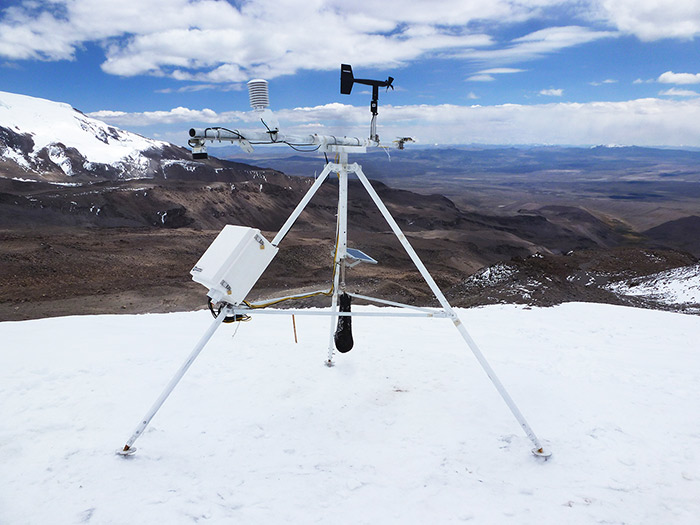







現在、アンデスの熱帯氷河は急いで後退しています。 これらの氷河は、ペルー南部の乾燥した冬と干ばつの間、恒久的な水源であると考えられています。手前にいるため、この状況は注目を集めています。 コロプナはペルー最大かつ最も高い火山で、リマの南1,000 km (620 マイル) のアレキパにあります。 最高標高は 6,400 m (21,000 フィート) で、ペルーで約 3 番目に高い地点であり、年間降水量が 400 mm (16 インチ) の最も乾燥した地域の 1 ヶ所です。
このような背景から、周辺地域の気候変動への適応を支援し続けてきた持続可能開発協会 (AEDES) は、ペルー国立気象水文サービス (SENAMHI) に連絡を取りました。印象的な山頂、キソキピナ (5,180メートル、16,995フィート) とワイタパラナ (4,760メートル、15,617フィート)に気象観測所を設置しました。これら2つの設置は、Comunidad Andinaプロジェクトによって資金が提供されました。
連絡中、SENAMHIとAEDESは、氷河の動態をより深く理解するために、コロプナの気象状況をモニタリングする共同プロジェクトを開始することに合意しました。Comunidad Andinaプロジェクトで使用されたものと同じステーションをいくつかCNR1の代わりにCNR4を使用し、RM Young 05103 風速および風向センサーのアルパインバージョンを使用しました。機器の配布に全力を尽くした EnviroEquip に特に感謝いたします。
設置作業は、トラックで 4 時間、ラバで 4 時間、ハイキングで 2 時間という長い旅を経て、9 月 7 日から 10 日の間に行われました。設置作業には、SENAMHI の技術者 4 名、AEDES の技術者 2 名、ペルー国立水資源局 (ANA) の氷河水文資源部 (UGRH) のエンジニア 1 名、および設置場所への機器の移動を手伝った地元住民が参加しました。グループは標高 5,570 メートル (18,275 フィート) のベース キャンプから作業し、設置場所は標高 5,800 メートル (19,000 フィート) でした。この標高は、アメリカ大陸、ヨーロッパ、アフリカで最も標高の高い気象観測所となり、これより高い標高に設置されている観測所はヒマラヤの観測所のみです。
現在、この観測所は気温(試験当日の20:30に記録された最低気温は-6.1°C)、湿度、風速と風向、気圧、正味太陽放射量、アルベド、積雪高などの情報を収集しています。この情報により、大気と氷河の間のエネルギー交換を知ることができ、この山頂にペルーで最も高い氷河がある理由を理解するのに役立ちます。